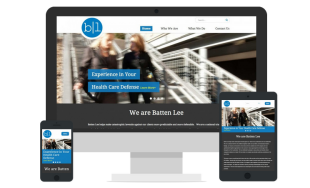Last spring, I was approached by my local chapter of the Legal Marketing Association about presenting alongside attorney Dana Hoffman of Young Moore on the Americans with Disabilities Act (ADA) and its application to law firm website design. The presentation was fun and informative, and I was honored shortly thereafter the opportunity to expand the focus for an audience of litigators at the 2017 Defense Research Institute’s Retail and Hospitality Conference in Chicago. I’ll be presenting on this topic this Friday alongside Amy Richardson of Harris Wiltshire & Grannis. Amy has worked on both the litigation and government enforcement sides of this issue and we’re both looking forward to talking with attorneys representing clients across the business spectrum on this interesting topic.
To that end, I wanted to share a short post on the history of the ADA and websites, an update of where things stand from a legal perspective in the United States, and then review a few guidelines and resources that you should keep in mind if you are a person managing a website for a public facing business or organization.
The Legal Perspective: ADA Compliance for Websites
As I’ve dug into this topic over the last year, I have to say I’ve been most fascinated by watching the process of a law originally intended for physical spaces be considered for interpretation in the digital space.
For a bit of background, Title III of the Americans with Disabilities Act of 1990 deals directly with places of public accommodation -- think hotels, restaurants, office buildings, schools, etc. -- and has set forth extremely clear guidelines on physical locations and the standards they should meet to serve disabled populations.
All of that was well and good in 1990, when the then-nascent Internet was not the ubiquitous presence in the lives of Americans that it is today. For example, retail shopping in-person at a mall in 1990 was booming, unlike today where online shopping has completely changed the game for retailers. As time and technologies evolved however, the Department of Justice (DOJ), the entity charged with enforcing the ADA, hinted but never definitively stated that Title III may indeed be applicable to websites.
Upon first recognizing this possible application of Title III of the ADA in 2003, the DOJ laid out a Voluntary Action Plan for government agencies and private entities, and later followed that up with a short list of recommendations in 2007. In 2010, the DOJ seemed to be picking up steam on this topic when they released a Notice of Advance Rulemaking -- stating that they were “considering revising the regulations implementing Title III of the ADA in order to establish requirements for making the goods, services...offered by public accommodations via the Internet, specifically at sites on the World Wide Web, accessible to individuals with disabilities.”
From this statement, it was forecasted by those in the accessibility community that formal guidelines would come down from the DOJ in 2015 -- a date which was later pushed out to 2017 for government agencies and 2018 for private businesses and entities.
Meanwhile, the tech community and our courts system were forced to deal with the issue on their own. First, the tech community coalesced around a set of standards via the World Wide Web Consortium, establishing the Web Content Accessibility Guidelines in 2008 and later updating them in 2012 (WCAG 2.0), when they were also adopted as an ISO standard. Today, web designers and developers across the world use WCAG 2.0 to guide their design and development, typically aiming to meet all of the standards under Level AA.
On the legal side, ambiguity in the law and the speed at which technology and dependence on the Internet has developed created an opportunity for litigation all over our nation. As these cases have moved through our system, the courts have been nearly split -- with the 1st, 3rd and 7th Circuits ruling that the ADA does apply to websites, while the 6th, 9th and 11th Circuits have ruled that it does not. These latter rulings have all been based on the interpretation that the ADA is focused on physical location and requires a nexus test. Other circuit courts in the United States have yet to rule on the topic.
A Look Ahead
In January of 2017 the federal government moved forward with the adoption of WCAG 2.0 AA as the standard for federal agency sites, leading many in the accessibility community to believe that a full adoption of the WCAG 2.0 Level AA standards by the DOJ for websites both public and private would be forthcoming. As of the writing of this post, that has neither occurred nor been added to the DOJ’s agenda, likely due to the installation of a new administration and other legislative priorities.
Without a crystal ball, it’s difficult to gauge where the Trump administration will direct the DOJ on ADA regulations in relation to websites moving forward, if they do at all. The administration has already emphasized a desire to move away from regulation and those with a vested interest in the application of the ADA to websites have taken that as a signal that the already thrice delayed process will continue to be pushed down the list of priorities.
Why Accessibility?
So, you may ask, if the courts are divided and the DOJ doesn’t currently have standards set -- or a timeline in place for setting standards -- around accessibility for private entities, why should you worry with having an accessible website for your business or organization?
Great question. From where I sit, here’s why:
- Your company’s website is your primary communications tool and a vital part of your infrastructure. Your clients and customers -- both current and potential -- are coming to you from a wide range of backgrounds, experiences and perspectives. It makes good business sense to have a site that is accessible to as many people as possible to demonstrate to your users and clients that you understand their needs and want to meet them where they are in order to best serve them.
- If you work to have a fully accessible website, you will already be up to standard when the ADA compliance regulations eventually evolve -- whether that’s in this administration or the next.
- Google and the government are already making asks around their expectations of accessibility as a cornerstone of website development. Google already rewards sites that check many accessibility boxes with higher rankings and the government has signaled that web accessibility standards will be required for government contractors. By building a more accessible website now, you may significantly impact your SEO and ranking potential, not to mention open the doors to possible work as a government contractor.
- Your site will also be intrinsically stronger in both design and content because you and your web team will have taken the time to think through accessibility standards -- often seen as best practice guidelines in our industry -- thus ensuring a more robust and user-friendly web presence for all populations.
- As long as this issue remains unclear and without set guidelines from the DOJ, companies like yours who do business on the web can expect that not bringing your site up to ADA standards could leave you open to the possibility of litigation.
Making Your Website Accessible
So, how do you start working toward a more accessible website for your business or organization?
- Start by deploying the WAVE Chrome Extension to help you identify ways to improve on your site.
- Review and frequently refer back to WCAG 2.0 and Web AIM for regulations and best practices, as set forth by the tech community.
- Make a plan for your site that includes the mission of working towards accessibility in your next website redesign -- likely in the next 1-3 years max.
- Keep compliance in mind when writing an RFP for your website and hiring vendors. Be sure to ask every web design or full-service digital marketing company you contract with about their experience building to WCAG 2.0 standards.
- Keep an eye on mobile -- pay attention to your site on mobile and be sure that any updates you make to create a more engaging web presence still strives for accessibility for all.
The Quick Jumpstart -- What to Look for Today
- Keep contrast in mind -- do headers and text stand out against the background of the site? Are they easy to read?
- Don’t use color to inform -- stay away from red!
- Deploy alt tags and descriptions for videos, animation and photography.
- Write clear, concise copy -- don’t forget translations if your business offers international services.
- Think like a screen reader: does your site work without CSS?
The Bottom Line
Accessibility is important and should be a part of your company or organization’s long-term digital presence strategy. As the web grows ever more refined and personalized, it will no longer be just other entities like the government, Google and the DOJ that expect your site to function with all possible populations in mind. Individual users of all backgrounds, abilities and experience will expect and demand that your site be clear, easy to use and accessible to all.





Comments
Hallie Kennedy NMC team member
Hi Keith,Thanks so much for your comment and question!
On Dec. 26, 2017, the DOJ withdrew the proposed rulemaking for Title II and Title III, effectively killing any forward progress on adoption (more on that here: https://www.law.com/dailybusinessreview/2018/03/01/website-operators-are-on-notice-recent-events-may-force-change/). While disappointing, this is not surprising, given the current administration's commitment to deregulation. That said, I fully expect the courts to continue to fill the gap and hold businesses accountable, so I would encourage you to take accessibility standards into account as you work up the governance for your enterprise intranet services. If it would be helpful for me to put you in touch with an attorney with experience in these matters, I'd be more than happy to do so. Feel free to shoot me an email anytime at hallie@newmediacampaigns.com. Best of luck!
Thanks again for your comment!
Hallie
Keith Heider
Excellent article, thank you for sharing.I'm writing the governance program for our enterprise intranet services.
Do you know if Title II of the ADA has been adopted by the DOJ for entities outside of the government?
C.Fulton
Excellent Article! Having my class review this article on website accessibility!Leave a comment